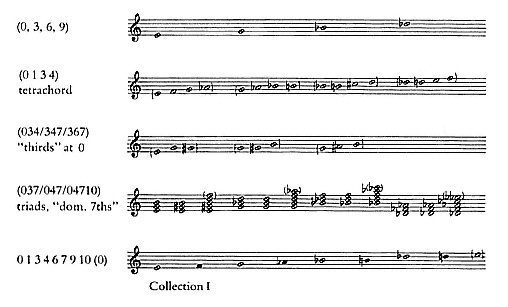Conclusions
As the last of the three big "Russian" ballets, The Rite exhibits features in rhythmic and pitch structure that were to remain characteristic of Stravinsky for the greater part of his composing career. The two types of rhythmic construction outlined in Chapters 3 and 4 are as conspicuously a part of pieces such as the Symphony of Psalms (1930) and the Variations (1964) as they are of The Rite . And while Renard, Les Noces , and Histoire du soldat mark a sudden preference for smaller, chamber-like ensembles, pitch relations in these works can be identified closely with those of The Rite . Even neoclassicism, for so long defined in terms of a sharp stylistic break with earlier trends, can often revealingly be heard and understood in relation to prior inclinations and concerns as detailed in these pages.
Of course, the octatonic articulation in neoclassical works often differs from that of The Rite and other works of the "Russian" category. Instead of the (0 2 3 5) tetrachord, an (0 1 3 4) tetrachord may frequently be inferred as a cohesive linear
[18] Tonality is here viewed in its restricted and historically oriented sense as a hierarchical system of pitch relations based referentially on the major-scale ordering of the diatonic set and encompassing an intricate yet fairly distinct set of harmonic and contrapuntal procedures commonly referred to as tonal functionality or "triadic tonality." The by now classic formulation of this view is given in Arthur Berger, "Problems of Pitch Organization in Stravinsky," in Benjamin Boretz and Edward T. Cone, eds., Perspectives on Schoenberg and Stravinsky (New York: Norton, 1972), p. 123. Berger writes: "Tonality . . . is defined by those functional relations postulated by the structure of the major scale. A consequence of the fulfillment of such functional relations is, directly or indirectly, the assertion of the priority of one pitch class over the others within a given context—it being understood that context may be interpreted either locally or with respect to the totality, so that a hierarchy is thus established, determined in each case by what is taken as the context in terms of which priority is assessed. It is important to bear in mind, however, that there are other means besides functional ones for asserting pitch-class priority; from which it follows that pitch-class priority per se: (1) is not a sufficient condition of that music which is tonal, and (2) is compatible with music that is not tonally functional."

Example 85
grouping. Indeed, in the Symphony of Psalms it surfaces as a kind of "basic cell" in the first and second movements, as Stravinsky himself noted in one of his "conversations" with Robert Craft.[19] Complementing the (0 1 3 4) tetrachord are the (0 3 4/3 4 7/3 6 7) minor-major third units and, most conspicuously, the triads and dominant sevenths as cited in Chapters 5, 6, and 7 (but in neoclassical works with an overall approach in disposition more varied than that encountered in The Rite or in "Russian" pieces generally). The typical neoclassical format is summarized in Example 85: an (0, 3, 6, 9) symmetrically defined partitioning of Collection I in terms of this collection's (0 1 3 4) tetrachords, (0 3 4/3 4 7/3 6 7) minor-major thirds, triads, and dominant sevenths at E, G, B


Such changes naturally coincide with changes in the diatonic articulation. In place of the D-scale ordering so prevalent in "Russian" contexts such as The Rite , the major scale is typical of neoclassicism, although both the E-scale and the A-scale may also at times be inferred. This major-scale reference is implied not only by the surface gesture and conventions of baroque and classical literature, but occasionally, and in however peripheral a manner, by certain tonally functional rela-
[19] Igor Stravinsky and Robert Craft, Dialogues (Berkeley: University of California Press, 1983), p. 77.
tions as well. What is often typical of the relations Stravinsky employed in these contexts can in turn be traced to an interacting partitioning of the octatonic collection as shown in Example 85; that is to say, to the manner in which this partitioning interacts with the gestures, conventions, and harmonic routines of the baroque and classical major-scale tradition.
These are obviously matters of considerable complexity, and have in fact been dealt with elsewhere in detail.[20] Consider, however, the tonic-dominant relationship insofar as this may here and there be felt as assuming a credible presence. The first movement of the Symphony of Psalms is a piece wherein octatonic blocks, accountable to Collection I with a background partitioning in terms of (E, G, B






Hence the neoclassical perspective becomes conditioned by considerations of The Rite and other works of the "Russian" period. And the attraction of this approach is that a distinctive musical presence is in some measure brought to bear. For while individual pieces naturally yield their own rationales, these are most advantageously approached as parts of a greater whole, of a wider listening experience. And since, for most enthusiasts, the sense of a musical identity or distinctiveness on the part of this composer is unmistakable, speculation along these lines is likely to prove tempting for many years to come.
[20] See Pieter C. van den Toorn, The Music of Igor Stravinsky (New Haven: Yale University Press, 1983).